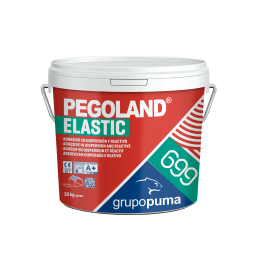 Pegoland® Elastic R2 T
Pegoland® Elastic R2 T

Improved white bicomponent reactive adhesive with excellent flexibility, no vertical sliding, ideal for ceramic tiles, mosaics, natural stones, polycarbonate panels and resin conglomerates. Suitable for interior and exterior areas; for both floors and walls. Excellent workability and optimum water resistance. Suitable for the adhesion of different materials on non traditional supports.
Additional information
Technical Caracteristics
Bicomponent reactive adhesive. Component A is made of epoxy-polyurethane synthetic resins, inert loads of fine grain size and organic additives. Component B is made of organic catalysts.
Advantages and Uses
- Excellent workability thanks to its thixotropy.
- Suitable for interior and exterior areas; for both floors and walls.
- Ideal for the placement of resin agglomerate shower trays.
- This multifunctional adhesive is suitable for different materials in non traditional substrates such as metal, wood, glass fibre, PVC, linoleum.
- This product is known for its high elasticity and ideal water resistance.
- This product produces very low emissions of volatile organic substances.
- Suitable for any kind of ceramic tiles, fine ceramic with or without reinforcement, glass fibre mosaics, any natural stone such as green marbles and slate, polycarbonate panels, resin conglomerates, super fine and flexible stone slabs.
- Suitable for gluing in polyester and glass fibres substrates on floors and walls, in traditional or elastic and flexible substrates such as wooden panels, metal surface and low density panels.
- Ideal for demanding conditions such as, wet areas, swimming pools, bathrooms, very transited floors and tiled floors which are exposed to extreme thermal conditions.
- Gluing in ceramic tiles and mosaics in wooden kitchen countertop.
- Gluing in mosaics and ceramic tiles in metallic areas for pre manufactured bathrooms.
- Gluing of natural stones even if they are instable in presence of moisture or that get spoiled easily.
- Gluing of ceramic tiles, mosaics, reinforced tiles, natural stones, polycarbonate panels or resin conglomerates placed on existent ceramic.
- Gluing of ceramic tiles, reinforced fine slabs, mosaics, natural stones, or resin conglomerates in radiant floors.
- Gluing of mosaics in structures and stencil made out of extruded polystyrene panels used in Arabic bathrooms, hammam, and spas.
- Gluing of ceramic tiles, pool mosaics even on water proof surfaces treated with Morcem Dry products.
- Product free from limitations for road, naval, air or rail transportation.
- Gluing of ceramic tiles or vitreous mosaic in polyester pools and in fibre glass baths.
- Gluing of ceramic, porcelain stoneware and big size fine slabs with or without reinforcement in exterior façades.
- Resin conglomerates tiles gluing.
- Suitable for waterproofing and placement of ceramic tiles or mosaic in interior wet environments.
- Product that limits the migration of salts through the mortar in the joints, reducing the possibility of efflorescence.
Suitable Substrates
- Conventional substrates based on concrete
- Substrates should be resistant , stable, healthy and clean; without any dust, or any other organic products.
- Sulphate base layers (anhydrite).
- Gama Niveland products levelling.
- Concrete in situ or prefabricated.
- Waterproofed with Morcem Dry products substrates.
- Surfaces coated with resinous decorative systems (pre-sanded).
- Concrete veneer, lime/ concrete veneer, plaster/ anhydrite based veneers.
- Wooden or metal panels, fibre glass, PVC; linoleum, parquet, existing ceramic tiles or natural stones; low density panels.
- All substrates should have the adequate flatness.
Application Procedure
- Pour the full package of component B (catalyst) on the component A (plaster). Mix it with the help of a helix drill at a low velocity until a homogeneous paste without lumps is obtained. Do not mix it with your hands. Both packaging are pre-dosed; and therefore, no errors should be contemplated in the mixture.
- Apply the product with the adequate notched trowel.
- Place the tiles on top of the fresh adhesive and press to make sure they touch the adhesive area before it exceeds its opening time, 50 minutes.
- When using the product in exterior areas, swimming pools, big areas, very transited floors, thin slab, detachable substrates, and any situation where important temperature fluctuations may occur, It's important to apply the adhesive in the substrate and the back part of the tiles in order to get a perfect layer covered with the adhesive and without holes.
- In case of waterproofing and placement, apply with a flat trowel a layer of at least 1 mm of product in the area to be waterproofed and once dry (after approximately 24 hours) apply the product with the corresponding notched trowel for the placement of the ceramic material.
- The working time of the product, in normal temperature and humidity conditions, is about 1 hour- High temperatures reduce it and lower temperatures increase it.
- Preserve the original joints (expansion, contraction, division, perimeter joints, etc.) and the position within tiles (2 mm minimum in interior areas and 5 mm in exterior areas).
- Ceramic areas should be protected, for at least 24 hours, from any possible rain. Tiles areas will be ready after 7 days.
- The joints will be done after 24 hours. Use the adequate mortar from the MORCEMCOLOR line, according to the type of joint.
NOTE: The lesser time between the combing and the placement of the tiles, the better the results.
Notched-trowel panel
Notched trowel teeth should be chosen depending on the format of the pieces to be placed.
| TILE FORMAT | NOTCHED TROWEL | GLUING |
| Small format / Mosaic |
U2 (2 x 2 x 2) U4 (4 x 4 x 4) |
1,1kg/m2 2,0kg/m2 |
| ≤ 60 cm format |
U8 (8 x 8 x 8) U9 (9 x 9 x 9) or n10 |
3,0kg/m2 3,5kg/m2 |
| > 60 cm format | U9 (9 x 9 x 9) or n10 | 5,0kg/m2 (double gluing) |
Recommendations
- Do not add lime, concrete or water to the product.
- Apply the product with temperatures between 10ºC and 30ºC.
- Do not apply the product in increasing humid surfaces.
- Check that all the necessary materials for the work you are going to carry out (ceramic material, levelers, adhesives, sealants, waterproof products, etc.) are the appropriate ones and are all well preserved.
- When using vitreous mosaic in polyester swimming pools, sand its surface in order to increase its roughness so as to improve the adhesive anchorage.
- Do not apply it in case of frost, rain, heavy wind or direct Sun light.
- A quicker drying takes place under extreme weather conditions (heavy wind or high temperatures)
- In pavements with more that 20/25 m2 in interior areas and 9/15 m2 in exterior areas or in areas with more than 15m of extension, it is recommended to leave partition joints with deformed material from PUMALASTIC. Check that these joints are perfectly sealed and waterproofed in the event of working in exterior areas.
- It is highly advisable to leave a free joint of expansion between the pavement and the wall or pillar, hidden by a skirting board of approximately 5 mm. These joints should be refilled with a deformable material from PUMALASTIC.
- In radiant heating floors, apply the product when the substrate reaches room temperature (between 5ºC and 30ºC), the heater should be off at least 48 hours earlier, and it should be switched on gradually, minimum after 7 days, once the job is over.
- In exterior façades the placing of the material will be done with anchor or mechanic attachment under any of the following circumstances: superior to 2400 cm2 format, if one of the piece sides is more than 60 cm long, if the weight is higher than 40kg/m2 or if it is more than 3 metres high.
- Never apply the product with the technique know as "by points"
- Temperatures, winds, substrate absorption and screed materials may alter the workability time.
- Do not use this product under any other circumstances that have not been described on this data sheet.
- On ceramic pavements (overlays), remove the poorly adhered parts and fill the holes with mortar the day before the product is applied. Ensure that the old ceramic is free of grease or wax traces, if necessary, mill the enameled surface until the loss of old ceramic glare. In case of doubt, carry out a preliminary test to establish the suitability of the solution provided.
Packaging and Storage
5 kg bi component plastic container in a 500kg pallet.
10 kg bi component plastic container in a 440kg pallet.
It can be stored up to 24 months in its original closed packaging and in the right position; keep it indoors and away from humidity. Do not expose to ice.
Technical data
(Statistic results obtained in standard conditions)
| Aspect | Component A: dense plaster Component B: dense liquid |
| Mixture proportions | Component A, 92,6 parts of weight Component B, 7,4 parts of weight |
| Open time (EN 1346) | > 0,5 N/mm2 after 50 minutes |
| Expected life time use of the plaster | Aprox.1 hora a T=+23°C |
| Attaching time | Aprox 1 hour |
| Initial resistance to shearing ( EN 12003) | > 2 N/mm2 |
| Resistance to shearing after water immersion (12003) | > 2 N/mm2 |
| Resistance to shearing after thermal shock (EN 12003) | > 2 N/mm2 |
| Deformability | Very deformable |
| Application temperature admitted | From +10°C a +30°C |
| Service temperatures | From– 40°C a +100°C |
| Transitability | Aprox. 24 hours at T=+23°C |
| Commissioning time | 7 days |
| Waiting time before filling the swimming pool | 7 days |
| Waiting time before filling the joints | Aprox. 24 hours |
| Acid resistance | Good |
| Alkalis resistance | Good |
| Tools and waste cleaning | Use water and a scourer with fresh product. With effective hardening, mechanically |
| Classification according to EN 12004 | R2T- improved with sliding, reactive adhesive |
| Customs classification | 35069190 |
Legal Disclaimer
The instructions for use are given according to our tests and knowledge and do not imply any commitment by GRUPO PUMA nor free the consumer from the examination and verification of the products for their correct use. Claims must be accompanied by the original packaging to allow a proper traceability.
GRUPO PUMA is not responsible, in any case, for the application of its products or constructive solutions carried out by the application company or other parties involved in the process and / or execution of the work, limiting the responsibility of GRUPO PUMA exclusively to the damages directly attributable to the supplied products, individually or integrated in systems, due to failures in their manufacturing process.
In any case, the drafter of the work project, the technical management or the person responsible for the work, or collaterally the application company or other parties involved in the process and / or execution of the work, must ensure the suitability of the products addressing the characteristics of them, as well as the conditions, support and possible pathologies of the work in question.
The values obtained by GRUPO PUMAS's products or its constructive solutions that, as the case may be, are determined by the EN standards or any other regulation that applies to it in each case refers exclusively to the conditions specifically stipulated in said regulation and that are referred to, among others, to certain characteristics of the support, humidity and temperature conditions, etc. without being them required in the tests obtained under different conditions, all in accordance with the relevant regulation.